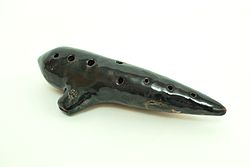Ocarina

Ocarina, author reported, c. 1900, Museu de la Música de Barcelona
|
|
| Other names | Sweet potato |
|---|---|
| Classification | Wind, Woodwind, Aerophone |
| Hornbostel–Sachs classification | 421.221.42 (Vessel flute with duct and fingerholes) |
| Related instruments | |
| Xun, Huaca, Slide whistle, Tin whistle, Molinukai | |
The ocarina /ɒkəˈriːnə/ or /oʊkəˈriːnə/ is an ancient wind musical instrument—a type of vessel flute. Variations exist, but a typical ocarina is an enclosed space with four to twelve finger holes and a mouthpiece that projects from the body. It is traditionally made from clay or ceramic, but other materials are also used—such as plastic, wood, glass, metal, or bone. An example of an ocarina made of an animal horn is the medieval German gemshorn.
The ocarina belongs to a very old family of instruments, believed to date back over 12,000 years. Ocarina-type instruments have been of particular importance in Chinese and Mesoamerican cultures. For the Chinese, the instrument played an important role in their long history of song and dance. The ocarina has similar features to the Xun (塤), another important Chinese instrument (but is different in that Ocarina uses an internal duct, whereas Xun is blown across the outer edge). In Japan, the traditional ocarina is known as the tsuchibue (kanji: 土笛; literally "earthen flute"). Different expeditions to Mesoamerica, including the one conducted by Cortés, resulted in the introduction of the ocarina to the courts of Europe. Both the Mayans and Aztecs produced versions of the ocarina, but it was the Aztecs who brought Europe the song and dance that accompanied the ocarina. The ocarina went on to become popular in European communities as a toy instrument.
...
Wikipedia
